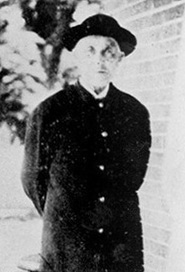The Uneasy Remembrance of Private Albert Cashier
Many of you will have heard the story of Pvt. Albert D. J. Cashier, Co. G, 95th Illinois Infantry. Private Cashier was born a woman, Jennie Hodgers (1843-1915). My colleague Damian Shiels, who blogs at Irish in the American Civil War, recently told Cashier’s story here.
Apart from the wartime masquerade, there are a couple of other remarkable things about Cashier’s life. (I use that name and the masculine pronoun, because that’s how Cashier chose to present himself for more than 50 years.) The first is that, whatever his reasons for adopting a male identity and entering the Union army, Cashier continued to present and live as a man, settling in the village of Saunemin, Illinois, about 90 miles southwest of Chicago. Cashier lived in Saunemin for more than 40 years, supporting himself with small jobs and living alone. As independent radio producer Linda Paul discovered two years ago, Albert Cashier was a strange, eccentric person:
For me though, probably the most fascinating part of this project was trying to unpeel the onion to find a more nuanced portrait of Jennie Hodgers. I found a person who could be kind to children, offering them a treat whenever they came to her home. But there was also a hot-headed, disingenuous, petty and unquestionably eccentric Jennie Hodgers. She had her foibles, just like the rest of us. . . .
A few years before the rest of the world found out about Cashier’s true gender, Cathy Lannon’s great grandmother made the discovery. She had heard that Albert was sick one day and so she asked a nurse to go over to help him out. In short order the nurse came running back and spluttered,“ Mrs. Lannon, he’s a full fledged woman!“ The nurse was so upset that she packed up and left town and Lannon’s great-grandmother in a great act of empathy, didn’t tell anyone about it, including her husband.
 In Cashier’s final years (right, c. 1913), it seems, a series of injuries resulted in a handful of people discovering his secret, but they kept quiet, and it was not until a year or so before Cashier’s death that the story became public and Cashier was revealed publicly as being female. Cashier was eventually confined to a state asylum where he was forced to wear a dress, very much against his will. By that time, Cashier was somewhat famous, and in August 1915 the Rockford, Illinois Republic noted that he was “failing rapidly. . . mental state is rapidly deteriorating.” When Cashier died in October, he was buried with full military honors, in the uniform of the Grand Army of the Republic, with a standard veteran’s headstone. (Six decades later, in the 1970s, a larger stone was dedicated, with both Cashier’s names on it.)
In Cashier’s final years (right, c. 1913), it seems, a series of injuries resulted in a handful of people discovering his secret, but they kept quiet, and it was not until a year or so before Cashier’s death that the story became public and Cashier was revealed publicly as being female. Cashier was eventually confined to a state asylum where he was forced to wear a dress, very much against his will. By that time, Cashier was somewhat famous, and in August 1915 the Rockford, Illinois Republic noted that he was “failing rapidly. . . mental state is rapidly deteriorating.” When Cashier died in October, he was buried with full military honors, in the uniform of the Grand Army of the Republic, with a standard veteran’s headstone. (Six decades later, in the 1970s, a larger stone was dedicated, with both Cashier’s names on it.)
Now one of my readers has passed along a news story from public radio WBEZ 91.5 in Chicago, telling the story of the restoration of the old soldier’s tiny house — and the unease that some locals still feel about discussing Cashier’s legacy. Returning in 2011 to Saunemin, Linda Paul resumes the story:
I’ve only just met the very affable Mayor Bob Bradford, but in no time flat, I’ve managed to get on his nerves.
See, the last time I was in town, a few years back, a couple of folks – a small number, really – weren’t so sure they wanted their town to celebrate the life of someone they considered a “cross-dresser.” So I may have gotten off on the wrong foot by asking Mayor Bradford if that’s still the case today.
“Well, I get a little perturbed when you use the word cross-dresser,” said Bradford.
Bradford said that anyone who uses that term just really doesn’t understand the story.
“And the story was, is, that Jennie Hodgers – Albert Cashier – was trying to make a living,” he notes. “And back in those days, a woman could not make a good dollar by being a housekeeper or doing laundry and so forth. But a woman could get three squares a day, and could make a good salary by serving in the army. So I think that was the reason. I don’t think it had to do with cross-dressers.”
I suppose if Mayor Bradford gets all squirmy at the mention of cross-dressing, maybe we shouldn’t even bring up the notion of transgender. 😉
In any event, it’s great that Saunemin’s residents have finally gone to the trouble and expense of restoring this small reminder of a very unusual Civil War story. I suspect that, in the coming years, they will wonder why they didn’t do it sooner, and why they were so uncomfortable with Albert Cashier’s legacy for so long.
___________
Image: Albert D. J. Cashier’s tiny house in Saunemin , Illinois, under restoration in 2010, via Pantagraph.com. Cashier photo via Abraham Lincoln Presidential Library and Museum.







This is a fantastic story and the house has been in storage in Pontiac, Il. for many years and as you show has been cared for by volunteers. Saunemin is just about an hour away and I have been there for the annual festival where we…the 104th Illinois…have honored Albert/Jennie at his/her grave.
I discuss why some women like Albert/Jennie did what they did in my U. S. History class and the students usually bring up the cross dressing/Transgender thing each year. It really gets them thinking and realizing that those who lived back then are really not that much different than we are today.
There are lots of examples of women who posed as men to enlist during the war, but none I’m aware of who completely adopted a new, male identity and maintained it, uninterrupted, for the rest of their lives. Cashier would likely never have been found out without being injured, and indeed never revealed his original identity as Jennie Hodgers — that came years after Cashier’s death. That alone must make this story unique, or very nearly so.
High degree of difficulty, no doubt. I rather doubt the % of the population that is transgender fluctuates much. It’s a question of whether they can safely/easily (“easily” is a poor word) act on it. In Jennie Hodgers/Albert Cashier’s time, it was neither safe nor easy, but he pulled it off.
Amazing.
I have been fascinated with Albert’s story, so much so that I have written a screenplay entitled: AKA Albert Cashier – The American Civil War. Shopping it around. Albert as a man could smoke, vote, participate in yearly parades with The Grand Army of the Republic for the contribution he made to our country. Also, receive more in pay than a woman – made sense. Jerrie
Thanks for your comment.
What makes Albert Cashier’s story intriguing is that he — and I use the masculine pronoun intentionally — was so completely matter-of-fact about it. It was his true identity, as far as I can tell. The CW is full of stories of women who disguised themselves as men for various reasons — to follow a husband or lover into the army, to conduct espionage, whatever — but it was always a temporary thing, and they went back to their original identity later. Albert began identifying and presenting as male before he entered the army, as I understand, and continued to do so until he was found out and institutionalized near the end of his life — which is the tragedy in this story.
Good luck with your screenplay!
I know that this was an article published years ago, but I became fascinated about Albert Cashier from reading articles like this one and have written an historical/fiction novel of the life and times of Albert Cashier entitled, A Velvet Fist in an Iron Glove: The Curious Case of Albert Cashier published as a Kindle Ebook at Amazon. If you are interested in my account, please check it out.
Martin J. Bradford